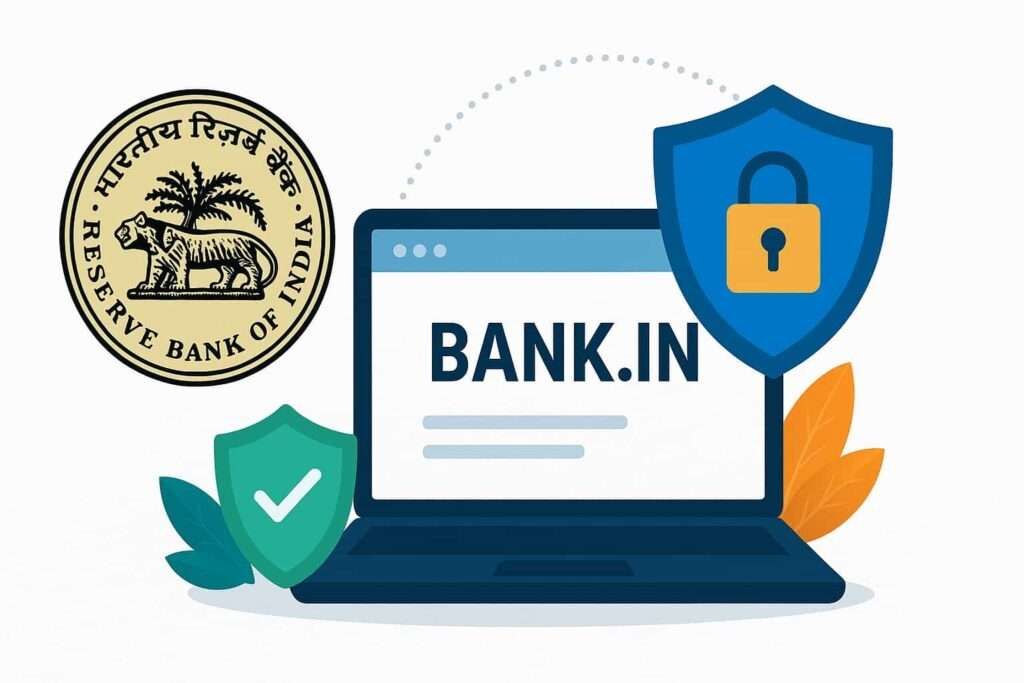8:00 PM, November 13 – Banks, including SBI, HDFC, Yes, across India are quietly switching their websites to the new “.bank.in” domain after the Reserve Bank of India (RBI) made it mandatory after the circular. And now, a fresh PIB Fact Check tweet has confirmed that the viral claim circulating online is true:
क्या भारतीय रिज़र्व बैंक ने सभी बैंकों को '.bank.in' डोमेन पर स्थानांतरित होने का निर्देश दिया है?#PIBFactCheck
— PIB Fact Check (@PIBFactCheck) November 12, 2025
✅ हाँ, यह दावा सत्य है।
भारतीय रिज़र्व बैंक (@RBI) ने सभी बैंकों को निर्देश दिया था कि वे 31 अक्टूबर 2025 तक अपने मौजूदा वेब डोमेन को नए ‘.bank.in’ डोमेन में… pic.twitter.com/MiR5N3KRT9
Yes, RBI directed all banks to migrate to “.bank.in” before October 31, 2025.
But the bigger questions still remain: Why did RBI force this change? Will Google rankings fall? And is website fraud in India really that serious?
Let’s break this down in simple language.
Why the RBI Forced Banks to Change Their Websites
This wasn’t a branding exercise. It was a safety move.
In the last two years, India has seen a sharp increase in online banking scams, especially fake websites that look identical to real bank websites.
Scammers were creating domains like:
- “hdfcbank-support.in”
- “sbicard-waiver.co.in”
- “pnb-feerefund.com”
And thousands of Indians lost money simply because the website looked real.
So RBI introduced one strong rule:
If it’s a real bank, its website must end with “.bank.in”. Nothing else. It tells the user that all over india, we have a single identity for rural banks, gramin banks, PSU banks, and private banks as well.
This domain is controlled, verified, and cannot be purchased by scammers.
Fraud Cases in India — Yearly Snapshot
| Year | Total Fraud Cases | Total Money Lost |
|---|---|---|
| FY23 | 9,097 cases | ₹18,000+ crore |
| FY24 | 10,218 cases | ₹30,000+ crore |
| FY25 | 13,516 cases | ₹36,000+ crore (Source: deccanherald.com) |
Rising online fraud was one of the reasons for that. India’s fraud numbers paint a worrying picture. Even when the number of cases dipped in some categories, the amount stolen kept increasing. More bold scammers, more dangerous tricks.
And the most common trick? Fake websites that look 99% like bank websites.
Real Story: How a Fake SBI Card Website Tried to Scam Me
Just last week, I — Nanne Parmar — got a call, supposedly from SBI Card.
The caller said:
“Sir, your annual fee waiver is approved. Please visit this link right now.” Fun fact, that guy know about i have SBI card, even he know which card i have.
The link was: SBIcard.feesremove.co.in
The moment I opened it, I knew it was fake. Being a web devolper for four years, I could instantly see it was a WordPress site, not an SBI website.
But here’s the scary truth: 99% of normal users would not notice. They would enter their card details and lose money in seconds.
This is exactly the type of scam RBI wants to eliminate using “.bank.in”.
Types of Online Banking Scams in India
| Scam Type | How It Works | Risk Level |
|---|---|---|
| Fake bank websites | Look exactly like real bank sites | Very High |
| Fake “bonus points” or “fee waiver” links | Sends SMS/calls with urgent links | High |
| UPI collect request fraud | Ask you to “receive” money but you end up sending | High |
| Digital arrest calls | Fake police/Cyber cell calls | Very High |
Unlike old scams, these new ones are well-designed, fast, and emotional.
Will Google Rankings Drop When Banks Change Domains?
Short answer: Yes, a little — but only temporarily.
- Banks may see a short-term drop because Google needs time to adjust. Most keywords and banking pages will drop on Google, so always check the last domain before visiting any banking portal.
- But long-term, “.bank.in” is safer, more trusted, and Google prefers safer domains.
- Rankings normalise within weeks.
So, no permanent loss.
How to Stay Safe Online
If you want to protect yourself from banking scams, follow these simple rules:
1. Check the domain — always
It must end with “.bank.in”. No exceptions.
2. Never click links from SMS or unknown callers
Banks never send links asking for OTP or card details.
3. Type the bank website manually
Avoid clicking Google ads for banks.
4. Enable alerts
Turn on SMS + email alerts for every transaction.
5. Use official apps only
Download from the Play Store or App Store — not from links.
My own brush with a fake SBI site proved one truth: in today’s India, trusting only ‘.bank.in’ isn’t optional—it’s survival.
Read More RBI updates – SGB Final Payout on November 13: This 2017 Tranche Delivers Rare 317% Gain Without Any Tax, Learn Newbie?







